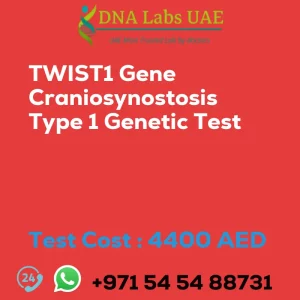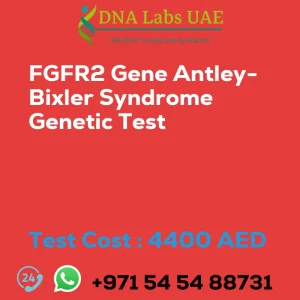CRLF1 Gene Cold-induced Sweating Syndrome Genetic Test
Introduction
Welcome to the blog of DNA Labs UAE, a genetic lab specializing in various genetic tests. In this blog post, we will discuss the CRLF1 Gene Cold-induced Sweating Syndrome Genetic Test, its cost, symptoms, diagnosis, and other important details.
Test Details
The CRLF1 Gene Cold-induced Sweating Syndrome Genetic Test is a type of genetic test that analyzes the CRLF1 gene for mutations or variations associated with cold-induced sweating syndrome. This genetic disorder is characterized by excessive sweating, particularly in response to cold temperatures.
NGS (Next-Generation Sequencing) technology is used in this test to examine the DNA sequence of the CRLF1 gene. It allows for the detection of specific genetic changes that may be responsible for the development of cold-induced sweating syndrome. By identifying mutations or variations in the CRLF1 gene, this test can provide a definitive diagnosis of cold-induced sweating syndrome. It can also help in determining the risk of passing on the condition to future generations and guide appropriate treatment and management options.
Test Components and Price
The CRLF1 Gene Cold-induced Sweating Syndrome Genetic Test is priced at 4400.0 AED. The test can be conducted using blood or extracted DNA, or even one drop of blood on an FTA card.
Report Delivery
The report for the CRLF1 Gene Cold-induced Sweating Syndrome Genetic Test is typically delivered within 3 to 4 weeks.
Test Type and Doctor
The test type for this genetic test is dysmorphology, which focuses on the study of abnormal physical features. The doctor responsible for conducting this test is a pediatrician.
Test Department
The CRLF1 Gene Cold-induced Sweating Syndrome Genetic Test falls under the Genetics department at DNA Labs UAE.
Pre-Test Information
Before undergoing the CRLF1 Gene Cold-induced Sweating Syndrome Genetic Test, it is important to provide the clinical history of the patient. Additionally, a genetic counseling session may be conducted to draw a pedigree chart of family members affected by the syndrome. This will help in understanding the inheritance pattern and the likelihood of passing on the condition to future generations.
Conclusion
The CRLF1 Gene Cold-induced Sweating Syndrome Genetic Test offered by DNA Labs UAE is a valuable tool in diagnosing and managing cold-induced sweating syndrome. By analyzing the CRLF1 gene using NGS technology, this test can provide a definitive diagnosis, assess the risk of passing on the condition, and guide appropriate treatment options. If you suspect that you or a family member may have cold-induced sweating syndrome, it is recommended to consult with a pediatrician and consider undergoing this genetic test.
| Test Name | CRLF1 Gene Cold-induced sweating syndrome Genetic Test |
|---|---|
| Components | |
| Price | 4400.0 AED |
| Sample Condition | Blood or Extracted DNA or One drop Blood on FTA Card |
| Report Delivery | 3 to 4 Weeks |
| Method | NGS Technology |
| Test type | Dysmorphology |
| Doctor | Pediatrics |
| Test Department: | Genetics |
| Pre Test Information | Clinical History of Patient who is going for CRLF1 Gene Cold-induced sweating syndrome NGS Genetic DNA Test. A Genetic Counselling session to draw a pedigree chart of family members affected with CRLF1 Gene Cold-induced sweating syndrome NGS Genetic DNA Test gene CRLF1 |
| Test Details |
CRLF1 Gene Cold-induced sweating syndrome NGS Genetic Test is a type of genetic test that analyzes the CRLF1 gene for mutations or variations associated with cold-induced sweating syndrome. This genetic disorder is characterized by excessive sweating, particularly in response to cold temperatures. NGS (Next-Generation Sequencing) technology is used in this test to examine the DNA sequence of the CRLF1 gene. It allows for the detection of specific genetic changes that may be responsible for the development of cold-induced sweating syndrome. By identifying mutations or variations in the CRLF1 gene, this test can provide a definitive diagnosis of cold-induced sweating syndrome. It can also help in determining the risk of passing on the condition to future generations and guide appropriate treatment and management options. |







